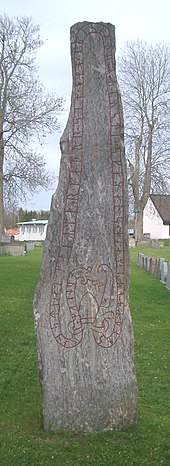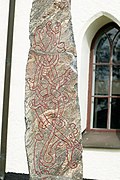Runestone from Västerljung
The runestone of Västerljung (Sö 40; RAÄ-Nr. Västerljung 230: 1) is a rune stone that is in the cemetery of the church of Västerljung in the municipality of Trosa in the east of Södermanland in Sweden .
The approximately 3.0 m high, slender stone, which was scratched in the 11th century (1020-1050 AD), was walled into the church wall until it was removed in 1959 and placed in its current location. It has a narrow, three-sided top. There are images on two of its sides, while the runic inscription is on the third. The long serpentine ribbon is connected at the bottom with an Irish belt . It is cut in the rune stone style Pr2 and comes from the rune master Skamhals, who also signed the rune stone Sö 323, but it is a homonym .
One of the pictures shows a man sitting on a chair. It is likely Gunnar ( Swedish Gunnar Gjukeson - German Gunther ) in the snake pit, one of the main characters in the Völsunga saga and brother-in-law of Sigurd Fafnesbane . The motif with which Gunnar tried to defend himself against the snakes with harp music comes from the Atlas song and Gunnar's harp strike and was a popular theme of the artists of the time. The snake pit scene is also depicted on one of Hunnige's picture stones. The other figures on the Västerljung stone have not been interpreted.
The text reads: "haunefR + raisti • at • kaiRmar • faþur • sin + haa • iR intaþr • o • þiusti • skamals • hiak • runaR þaRsi" ("Hunnäv set (the stone) after Germar, his father. He died in Tjust. Skamhals made the runes. ")
It is not clear whether Tjust refers to Tystberga in Södermanland or to Tjust near Västervik in Småland .
- Runestone from Västerljung
literature
- Elmer H. Antonsen: A Concise Grammar of the Older Runic Inscriptions . Max Niemeyer Verlag, Tübingen 1975, ISBN 3-484 60052-7 .
- Klaus Düwel: Runic lore. 4th edition. Verlag JB Metzler, Stuttgart / Weimar 2008. (Metzler Collection 72)
- Lydia Klos: Runestones in Sweden - studies on location and function . In: Supplementary volumes to the Reallexikon der Germanischen Altertumskunde , Vol. 64, Heinrich Beck, Dieter Geuenich, Heiko Steuer (Eds.). De Gruyter, Berlin / New York, 2009. ISBN 978-3-11-021464-2
- Åke Ohlmarks: 10 0 Svenska Runinskrifter . Bokförlaget Plus, Borås 1978.
- Hermann Reichert: Lexicon of Old Germanic Personal Names Vol. 1: Text, Vol. 2: Register. Böhlau, Vienna 1987, 1990.
Individual evidence
- ↑ In the legend, the Hun king Attila (Etzel) had King Gunnar thrown into a snake pit so that he might be killed by the snakebites. Except for one snake, Gunnar managed to bring all snakes to sleep by the shackled king playing the harp with his toes. The one snake that stayed awake bit him in the heart - this was Attila's mother who had turned into a snake.
Web links
Coordinates: 58 ° 55 ′ 19.9 ″ N , 17 ° 26 ′ 56.4 ″ E




